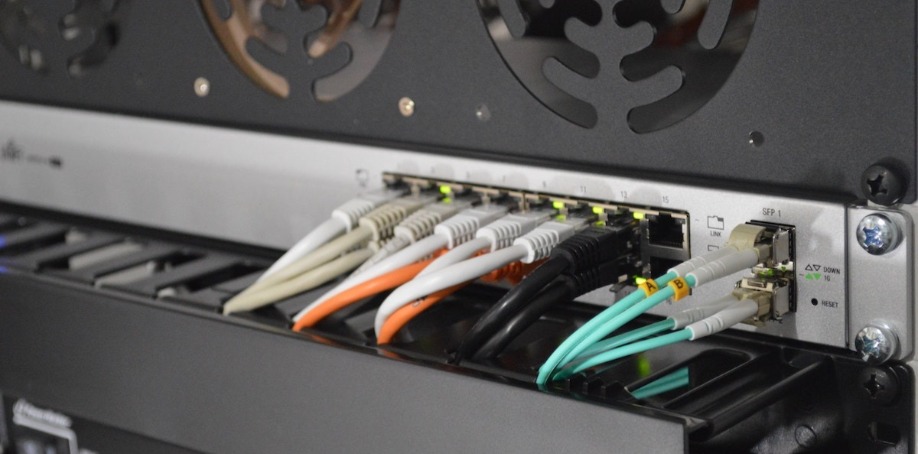
In a rapidly changing industry that's poised to transform forever, the choices that designers and integrators make right now are crucial. That's why it's so important to understand the difference between AV standards and infrastructures, and the practical use applications of each.
HDBaseT and Software Defined Video over Ethernet (SDVoE) both allow transmission of AV signals over greater distances. But they are far from similar. If you want your AV solution to be successful now and in the future, understanding the difference between the two is key.
What is HDBaseT?
HDBaseT is a consumer and commercial connectivity standard that uses Cat 5e cables to transmit uncompressed, high definition video, audio and other signals between sources and remote displays over a distance of up to 100 meters. In comparison, HDMI can only transmit signals over 12m of cable.
Anixter calls HDBaseT the global standard for “the transmission of ultra-high-definition audio and video, Ethernet, controls, USB and up to 100W of power over a single cable.”
That claim is no exaggeration. One of the benefits of HDBaseT is that it avoids the need for compression. This means that high image quality and delivery speed are achieved, says Laura Hood, Aten product specialist at True Colours. The technology is in some ways future-proofed because it is “more than capable of delivering 4K/UHD images and 3D video.”
HDBaseT brings an endless stream of possibilities for both vendors and installers, says HDBaseT Alliance president Ariel Sobelman. She explains that the technology can be applied in a variety of situations within a single room or across an entire campus.
Such portals can also be used to collate and organize diverse patient data from EHRs and even consumer devices like fitness trackers. Crucially, says Edward Yu, a primary care physician and medical director of quality at Palo Alto Medical Foundation, this data will be presented in a way that patients can understand, meaning that portals provide insights, action plans and links to appropriate guidelines. “There is the potential for healthcare that's happening in the doctor's office to move back to the patient.”
The importance of high quality and low-latency video in these situations cannot be stressed enough. Not only can the healthcare professional make sure that any medical or consumer devices are positioned correctly, they can also train patients how to collect data and draw insights from it.
What is SDVoE?
While HDBaseT is the leading standard for transmission of AV via cable, SDVoE is arguably the leading standard of AV transmission over internet protocol.
Rather than leveraging matrixes, switches and cabling to transmit AV, SDVoE leverages an ethernet to bring AV into the realms of IT. Indeed, SDVoE President Justin Kennington believes that SDVoE is the only true full stack solution to AV over IP. Other AV over IP standards may support some of the OSI 7 layers (a model that measures the interoperability of different communication systems), but only SDVoE address all seven layers.
This means that, according to SDVoE Alliance, “all AV distribution and processing applications that demand zero-latency, uncompromised video can benefit from SDVoE technology.”

Which Standard is Best for Integration?
"For point-to-point distribution, HDBaseT hands-down is the better value,” says Paul Harris, CEO of Aurora Multimedia. Harris' reasons are simple: In addition to being low cost, low power and low heat, HDBaseT is easily distributed.
For small scale AV solutions, HDBaseT may still be the best solution. But it probably won't be in the vast majority of installations. As we have discussed previously, AV over IP is more scalable, more efficient and more cost-effective than matrix switches.
For many business leaders such as Kamran Ahmed, CEO and co-founder of AptoVision, AV over IP has changed the industry forever. “The days of customized AV switches (such as HDBaseT) are limited since the research and development investment required to develop them is immense and cannot match the global r&d in standardized Ethernet switches.”
Ahmed is so confident in the power of AV over IP that he has even gone on record to say that 80 percent of AV applications will use IP within the next three to four years. As more designers and integrators embrace SDVoE's open and standardized approach, matrix switchers and proprietary AV over IP are becoming outdated and uncommon.
This is one of the reasons why Bob Michaels, CEO of ZeeVee, a member of the SDVoE alliance, made a conscious decision not to go down the HDBaseT route. He also sees it as a proprietary technology that will probably become irrelevant in two or three years.
“Audio and control were already in the Ethernet domain. We saw the silicon coming for the ability to move video continuously over Ethernet to address the requirements of the AV market, and we said, this is the way to go.”
BrightSign CEO Jeff Hastings agrees. Hastings sees the world moving from “a separate point-to-point network solution (HDBaseT) to a more unified network solution that uses standard networking technologies.”

Is SDVoE the Only Choice for an AV Over IP Solution?
Not necessarily. While it is the most popular standard, it's certainly not the only one. In fact, integrators who have previously embraced the HDBaseT standard can continue to do so while using an AV over IP solution.
In 2017, the HDBaseT Alliance rolled out a new HDBaseT over IP (commonly called HDBaseT-IP) infrastructure. The Alliance debuted a string of products on their new platform at that year's Infocomm conference.
The Alliance describes HDBaseT-IP as an expansion of the existing HDBaseT standard. It enables the distribution of HDBaseT 5Play (the five different elements that can be transported using HDBaseT) over an internet protocol.
“HDBaseT over IP brings unprecedented modularity and breadth of scope to the existing HDBaseT solutions available today,” says Micha Risling, chair of the HDBaseT Alliance marketing committee. Rather than having to switch their entire AV setup to SDVoE or another standard, integrators and designers can combine their traditional HDBaseT installation with an effective AV over IP solution.
But not everyone is optimistic about the new solution. Gary Kayye, founder of rAVe Publications, worries that HDBaseT-IP will be plagued by the same issues that haunt HDBaseT, including interoperability.
He says that it's often difficult to connect HDBaseT products across brands. “In some cases, connecting Brand A's to Brand B's will cause harm to one or the other. In a few cases, projectors have even been destroyed.” Kayye sees HDBaseT-IP as a similar disaster waiting to happen.
CEPro's Jason Knott has called HDBaseT-IP vs. SDVoE the next battle for the living room, with both vying to become the standard for AV over IP. Which system will come out on top isn't clear yet.
Usually, in the case of competing technologies, the winner is decided based on which one offers the most beneficial applications for the users — or the best apps, says Christie senior product manager Karl Johnson.
Tha's no good for integrators looking to build new AV solutions right now. Most AV integrators won't be able to wait and see which standard prospers. Ultimately, both standards are very good at providing lossless video, says Paul Zielie, manager of enterprise solutions at Harman Professional.
Rather than hedging your bets on the standard that you think will ultimately reign supreme, take the advice of Crestron's Alex Peras. “Leverage a flexible architecture that enables you to deliver results the business needs today and tomorrow.”
AV over IP enables integrators and businesses to evolve their AV solution over time. You don't need to get the entire infrastructure perfect today, but you do need to solve business needs today. That's what should drive your decision when choosing between standards.
Images by: Steve Johnson, Thomas Jensen, Anastasia Dulgier


